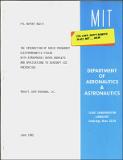The interaction of radio frequency electromagnetic fields with atmospheric water droplets and application to aircraft ice prevention
Author(s)
Hansman, Robert John
DownloadFTL_R_1982_05.pdf (6.499Mb)
Other Contributors
Massachusetts Institute of Technology. Flight Transportation Laboratory
Metadata
Show full item recordAbstract
In this work the physics of advanced microwave anti-icing systems, which pre-heat impinging supercooled water droplets prior to impact, is studied by means of a computer simulation and is found to be feasible. In order to create a physically realistic simulation, theoretical and experimental work was necessary and the results are presented in this thesis. The behavior of the absorption cross-section for melting ice particles is measured by a resonant cavity technique and is found to agree with theoretical predictions. Values of the dielectric parameters of supercooled water are measured by a similar technique at X = 2.82 cm down to -17 0 C. The hydrodynamic behavior of accelerated water droplets is studied photographically in a wind tunnel. Droplets are found to initially deform as oblate spheroids and to eventually become unstable and break up in Bessel function modes for large values of acceleration or droplet size. This confirms the theory as to the maximum stable droplet size in the atmosphere. A computer code which predicts droplet trajectories in an arbitrary flow field is written and confirmed experimentally. Finally, the above results are consolidated into a simulation to study the heating by electromagnetic fields of droplets impinging onto an object such as an airfoil. Results indicate that there is sufficient time to heat droplets prior to impact for typical parameter values and design curves for such a system are presented in the study.
Description
June 1982 Also issued as an Ph.D. thesis, Massachusetts Institute of Technology, Dept. of Physics, 1982 Includes bibliographical references (p. 188-191)
Date issued
1982Publisher
Cambridge, Mass. : Massachusetts Institute of Technology, Flight Technology Laboratory, 1982
Other identifiers
13195159
Series/Report no.
FTL report (Massachusetts Institute of Technology. Flight Transportation Laboratory) ; R82-5
Keywords
Airplanes, Water vapor, Atmospheric, Electromagnetic fields, Radio frequency, Ice prevention